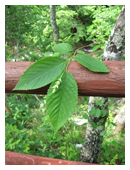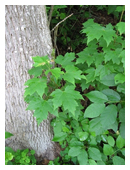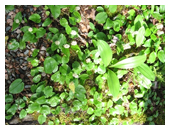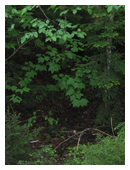Many of the woods often used in mills can be found around the mill site.
- White Ash (Fraxinus americana) provides a strong fine-grained hardwood for small hand tool handles.
- Hemlock (Tsuga canadensis) would have been harvested to build and maintain the building itself.
- Where strength and durability were paramount, Ironwood (Hop-hornbeam) or Ostrya virginiana is predominant in central Nova Scotia along streams and rivers.

- Sugar maple (Acer saccharum). Sugar Maple of course is a premier furniture, flooring species and what we burn to dry our oats and impart a special quality to our product.

The trail above the mill is a mixed forest of both deciduous and conifer trees. However there are more conifer trees. Therefore the groundcover also differs. Here you will see many plants are associated with mixed forests.
- Two typical plants in shady locations beneath these trees are Clintonia borealis (Clintonia Lily; Blue-bead Lily) and Wild Lily-of-the-Valley or Canada Mayflower (Maianthemum canadense). Both are colonial plants….they are never alone.

- Moosewood appears in small shady depressions or on slopes, this maple is a favorite browse of ungulates. Differing from other maples, the large leaves are toothed on the edge, but with only 3 points. It is also called Striped Maple (Acer pennsylvanicum).

- You will notice leafy lichens on the trunks of the larger deciduous trees, these are lung lichens, (Lobaria pulmonaria). Their presence may indicate a forest that has not been disturbed in some time.
